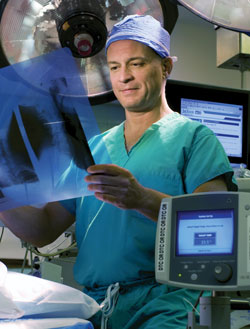Cool Therapy
Hypothermia proven effective to treat spinal cord injury
 |
| Allan Levi, M.D., Ph.D., is the lead author of a study demonstrating the effectiveness of hypothermia to treat acute spinal cord injury. |
Two years ago on a football field in Buffalo, New York, NFL player and former Miami Hurricane Kevin Everett suffered a spinal cord injury, and many believed he would never walk again. Everett was given a hypothermic treatment, the introduction of a cold saline solution that is thought to decrease damage to the spinal cord, while being transported to the hospital. It was a treatment Everett’s doctor learned about through the cutting-edge research pioneered by scientists at The Miami Project to Cure Paralysis at the Miller School.
“Everett’s doctor made a major step of translating what we were doing in some
of the preclinical experimental studies and just starting
in people, to actually treat this football player and have him walk again,” says W. Dalton Dietrich, Ph.D., scientific director of The Miami Project to Cure Paralysis.
Now, two years later, the first evidence that the use of mild hypothermia is both a safe and potentially effective strategy in acute spinal cord injury has been published by researchers from the Department of Neurological Surgery and The Miami Project at the Miller School.
In the study, 14 patients with the most severe form of cervical spinal cord injury were treated with 48 hours of modest intra-vascular hypothermia at Jackson Memorial Hospital and compared with a control group of 14 age- and injury-matched subjects. All of the patients were graded as AIS-A, which means a complete injury, according to the American Spinal Injury Association Impairment Scale.
“We were able to demonstrate
that it is safe to do surgery under hypothermia and maintain that temperature after surgery before rewarming, and we then followed
the patients for one year to assess their neurological outcome and complications,” says Allan Levi, M.D., Ph.D., professor of neurological surgery, principal investigator, and lead author of the study. “No patient experienced neurological deterioration as a result
of the treatment, and almost half showed improvement of one or more grades on the AIS scale.”
In a previous paper published
in the Journal of Neurotrauma,
Levi and his colleagues were able to determine that the treatment was safe
and within what time frame it needed to be administered. The latest paper
in press in Neurosurgery moved the research forward even further.
“We were able to deliver the treatment within eight hours of
injury with no significant difference
in complications compared with the control group,” explains Levi. “And
at one year, six of the 14 patients improved one AIS grade or better, and one man is walking. These findings demonstrate very clearly the need for additional controlled studies on the use of hypothermia in spinal cord injury.”
Most recent clinical research has focused on the use of cooling for head injury, stroke, and heart attack, and
up until now there has not been any clinically relevant data available to support its use for spinal cord injuries.
“In North America, the University of Miami has been the leading institution using hypothermia therapy on spinal cord injury patients; it is our standard of care when patients arrive
at the hospital,” says Levi. “Based on our decades of basic science work and the literature on hypothermia in head injuries, we designed and implemented our own protocol and are now leading the way in developing what we hope will be multicenter trials.”
|


